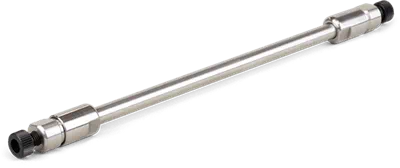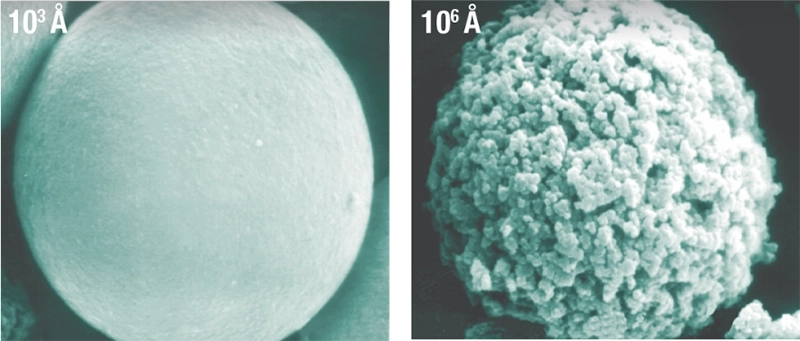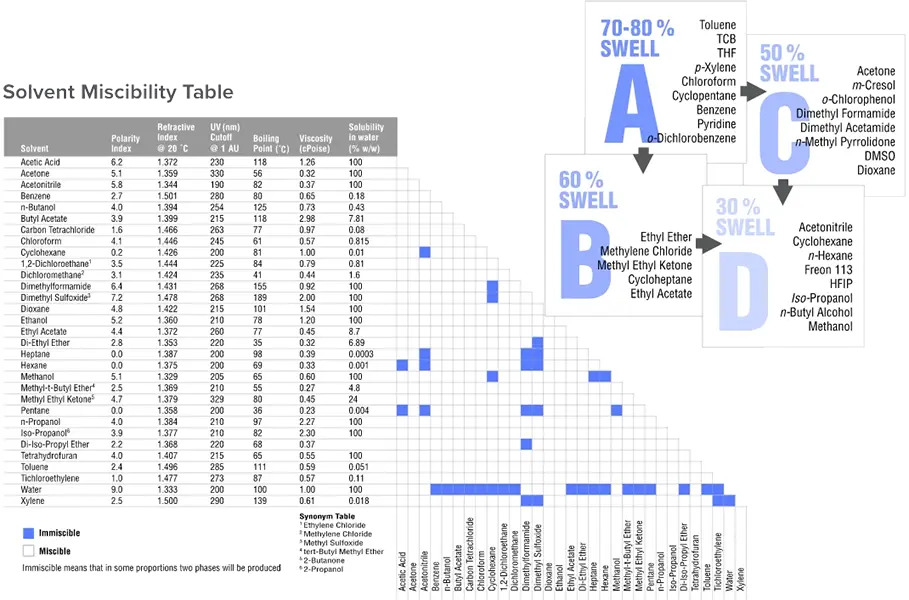
Phenogel GPC Columns
Enhance Resolution for Polymer Analysis using Non-Aqueous GPC/SEC
Phenogel size exclusion columns for gel permeation chromatography (GPC) are composed of highly cross-linked styrene-divinylbenzene (SDVB) and achieve high resolution and tight linear calibration curves. Phenogel GPC columns are available in seven different pore sizes, ranging from 50 Å to 106 Å; and a linear bed configuration. Pore size distribution and pore volume are closely controlled parameters in the manufacturing process, accounting for high resolution, tight linear calibration curves, and excellent column-to-column reproducibility. USP L21 packings available.
- 5 and 10 µm particle sizes
- Narrow bore (4.6 mm ID) solvent-saver columns available
- Highly cross-linked for mechanical and chemical stability
- Temperature stable to 140 °C.


Use Phenogel GPC Columns for Separations of Low, Moderate, and High Molecular Weight:
|
|
Phenogel Non-Aqueous GPC/SEC Columns
Phenogel packing materials are made from styrene-divinylbenzene by emulsion polymerization under conditions to optimize pore size, total pore volume, particle size, and degree of cross-linking. The results yield gel permeation chromatography (GPC) materials that provide very high resolution, rugged durability, and wide solvent compatibility.

Solvent and Temperature Compatibility
Solvent Selection Table
| Recommended GPC Solvent | Sample | Suggested Temp. |
|---|---|---|
|
THF
|
Polystyrenes |
Ambient
|
| Polybutadienes | – | |
| Epoxy Resins | – | |
| Phenolic Resins | Ambient | |
| Polymethyl Methacrylates | – | |
| Polyethylene Glycol | – | |
|
HFIP*
|
Polyamides (Nylon) |
30 °C
|
| PET/PETP | – | |
|
Dichloromethane
|
Naphthalene |
–
|
| Diethylhexyl Phthalate | Ambient | |
|
Toluene
|
Polyisobutylene |
Ambient
|
| Polyisoprene | – | |
| Silicone Oils | – | |
|
DMF
|
Polyethylene Oxide |
50 °C
|
| Polyvinylpyrrolidone (PVP) | 40 °C | |
| Cellulose Acetate | – | |
| Hydroxyethylcellulose (HEC) | – | |
| Chlorinated Rubber | – |
*HFIP (hexafluoroisopropanol) allows polymers such as polyamides and PET that are analyzed at a temperature of 135 °C and higher to be analyzed at temperatures below 100 °C. The narrow particle distribution of Phenogel columns eliminates the problem of overlapping peaks and band broadening that is typically associated with using this solvent with traditional GPC columns.
Phenogel columns are temperature stable to 140 °C which is important for applications involving solutes with limited solubility at ambient temperatures, or where solubility considerations demand the use of viscous solvents such as DMF or DMSO. At higher temperatures, eluent viscosity is decreased and mass transfer is enhanced, with the effect of increasing sample resolution. This temperature stability is particularly useful when analyzing polymers such as polyethylene and polypropylene which require higher temperatures.
Solvent Compatibility Table
| Phenogel Pore Size: | |||||||||
|---|---|---|---|---|---|---|---|---|---|
| Mobile Phase Solvent | 50 Å | 100 Å | 500 Å | 103 Å | 104 Å | 105 Å | 106 Å | Linear & Mixed |
Suggested Operating Temp. |
| Acetone | Y | Y | Y | Y | Y | Y | Y | Y | |
| Benzene | Y | Y | Y | Y | Y | Y | Y | Y | |
| Carbon Tetrachloride | Y | Y | Y | Y | Y | Y | Y | Y | |
| Chloroform | Y | Y | Y | Y | Y | Y | Y | Y | |
| 30 % HFIP/Chloroform | Y | Y | Y | Y | Y | Y | Y | Y | |
| Diethyl Ether | Y | Y | Y | Y | Y | Y | Y | Y | |
| Dimethylacetamide (DMAC) | Y* | Y | Y | Y | Y | Y | Y | Y | 60 °C |
| Dimethylformamide (DMF) | Y* | Y | Y | Y | Y | Y | Y | Y | 60 °C |
| Dioxane | Y | Y | Y | Y | Y | Y | Y | Y | |
| DMSO | Y* | Y | Y | Y | Y | Y | Y | Y | 60 °C |
| Ethyl Acetate | Y | Y | Y | Y | Y | Y | Y | Y | |
| Hexafluoroisopropanol (HFIP) | Y | Y | Y | Y | Y | Y | Y | Y | |
| Hexane | Y | Y | Y | Y | Y | Y | Y | Y | |
| M-Cresol | Y* | Y | Y | Y | Y | Y | Y | Y | 100 °C |
| Methyl Ethyl Ketone | Y | Y | Y | Y | Y | Y | Y | Y | |
| Methylene Chloride | Y | Y | Y | Y | Y | Y | Y | Y | |
| 0-Chlorophenol | Y* | Y | Y | Y | Y | Y | Y | Y | 100 °C |
| 0-Dichlorobenzene | Y* | Y | Y | Y | Y | Y | Y | Y | 135 °C |
| Quinolin | Y* | Y | Y | Y | Y | Y | Y | Y | 60 °C |
| Tetrahydrofuran | Y | Y | Y | Y | Y | Y | Y | Y | |
| Toluene | Y | Y | Y | Y | Y | Y | Y | Y | |
| Trichlorobenzene | Y* | Y | Y | Y | Y | Y | Y | Y | 135 °C |
| Water | N | N | N | N | N | N | N | N | |
| Xylene | Y | Y | Y | Y | Y | Y | Y | Y | |
*Not recommended on 5 µm 50 Å columns.
N = Not Compatible
Y = Compatible
Solvent Switching Considerations
Column life can be maximized by dedicating certain columns to certain solvents. This will also minimize solvent switches. If care is not taken, a void may occur.













